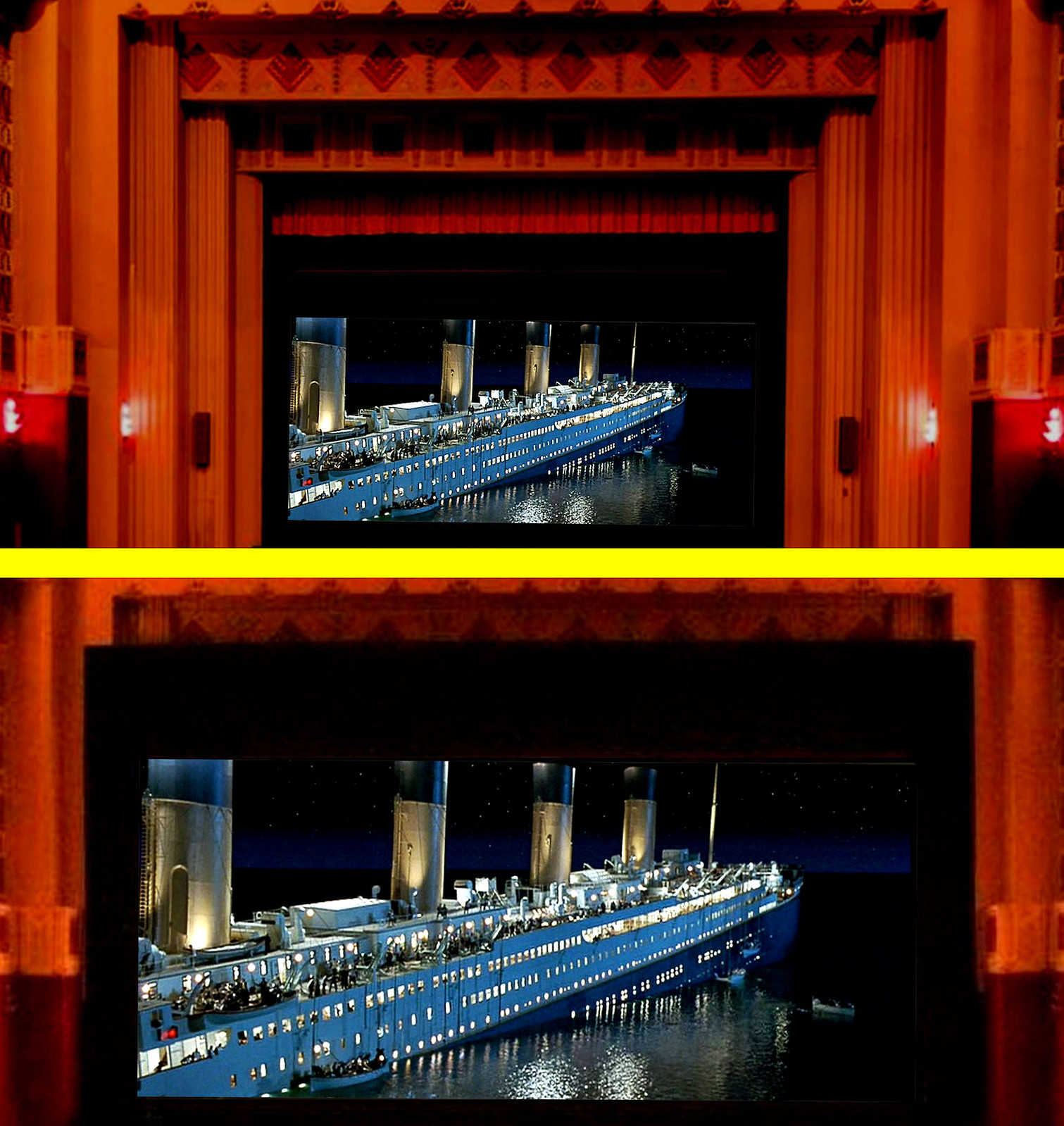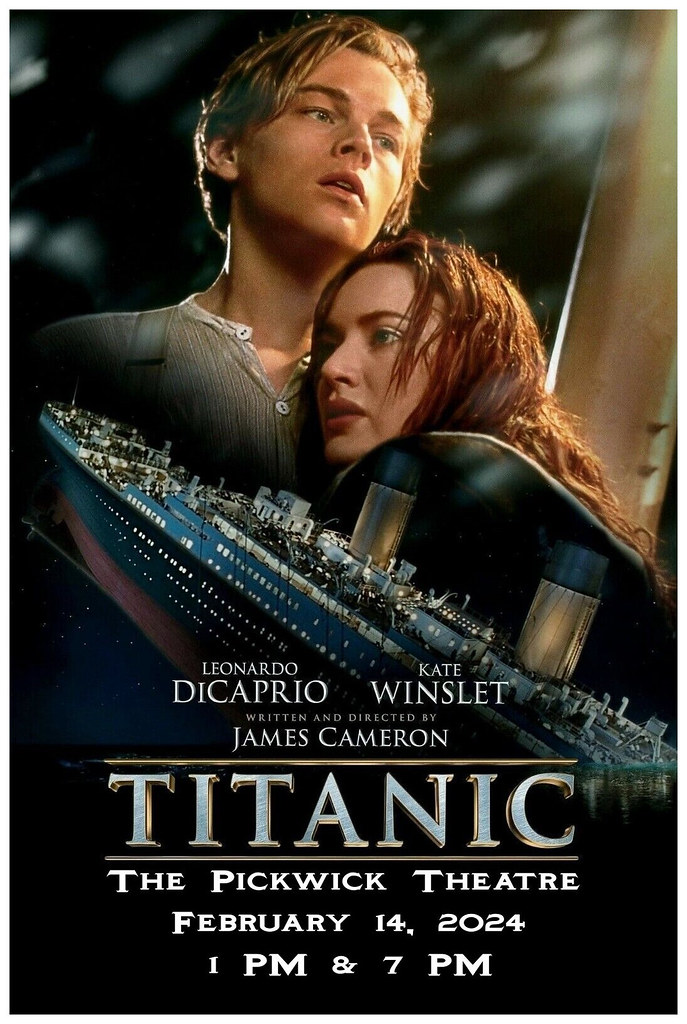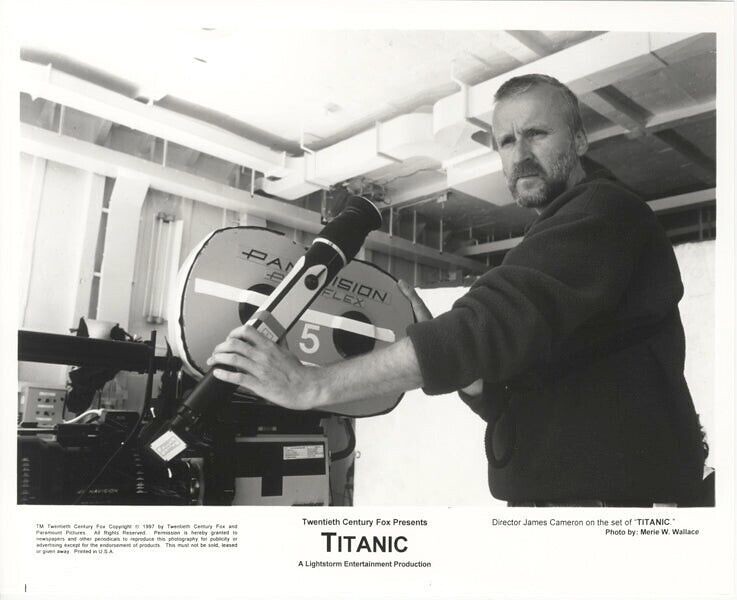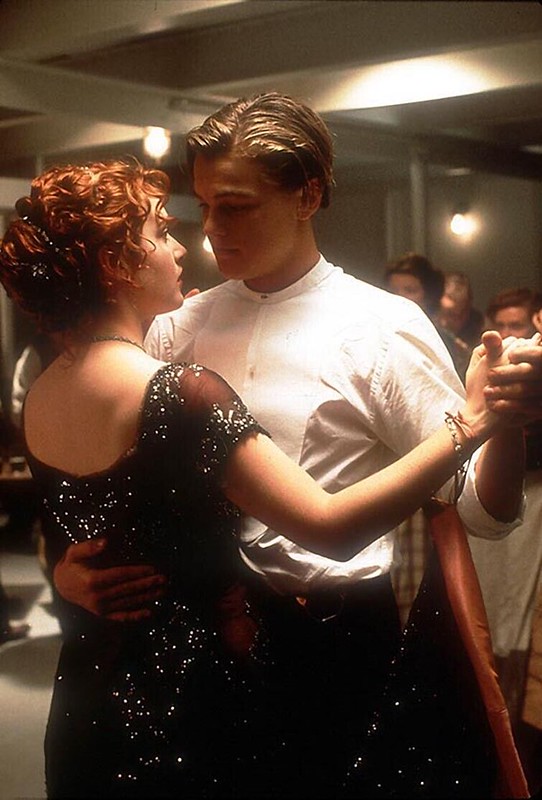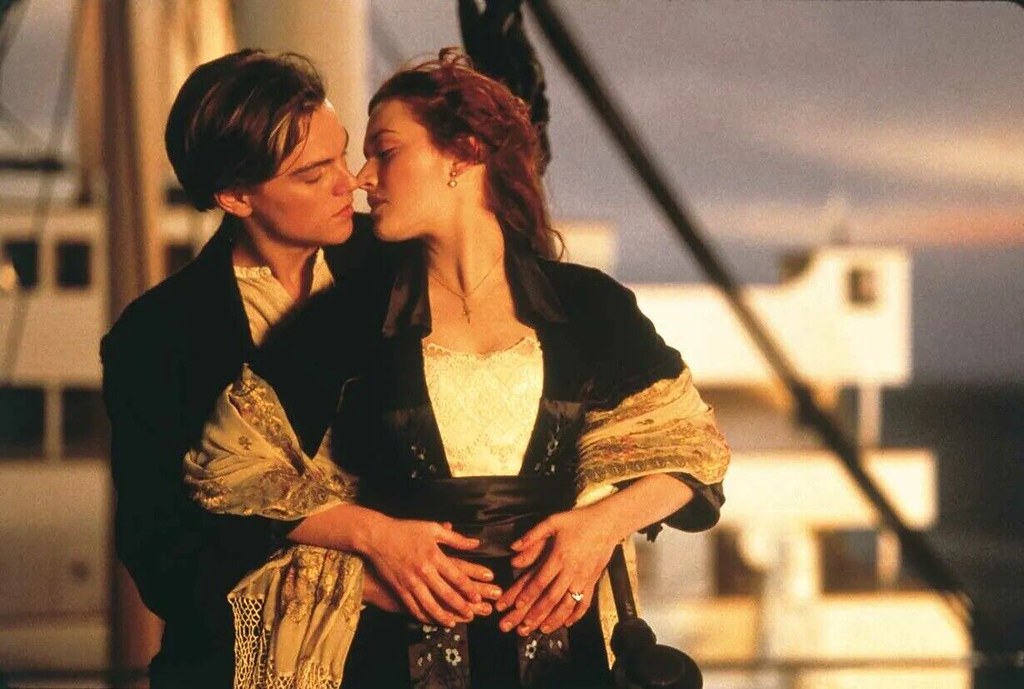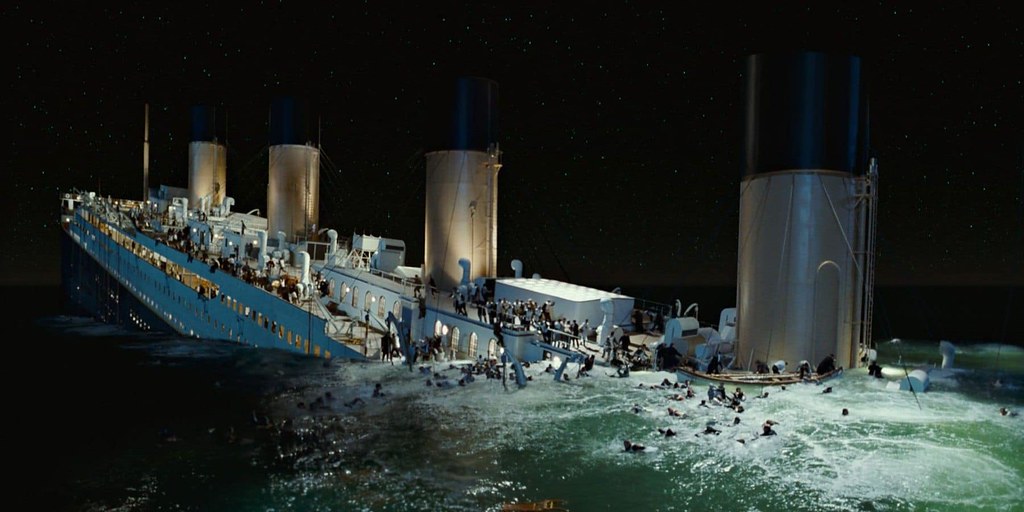WHAT: Titanic (1997, DCP, 194 min.)
WHEN: February 14, 2024 1 PM & 7 PM
WHERE: Pickwick Theatre, Park Ridge, IL
WHAT ELSE: Organist Jay Warren performs pre-show music at 6:30 PM.
HOW MUCH: $12/$10 advance or $10 for the 1 PM matinee.
Advance Tickets: Click Here and select date.
“The story could not have been written better had it been fiction… The juxtaposition of rich and poor, the gender roles played out unto death (women first), the stoicism and nobility of a bygone age, the magnificence of the great ship matched in scale only by the folly of the men who drove her hell-bent through the darkness. And above all the lesson: that life is uncertain, the future unknowable… the unthinkable possible.” ~ director James Cameron
At the last show someone asked me which version of Titanic would I be showing. The version that will fill a theatre… Everyone who has seen the 1997 movie directed by James Cameron remembers some aspect of it. They recall Leonardo DiCaprio’s “I’m the king of the world!” line or Celine Dion belting out her ballad, “My Heart Will Go On,” or the on-screen love story itself, which the song lyrics so well encapsulate. And everyone remembers the sinking, of course, which had never been portrayed in movies quite as authentically as it was here in this film. There are few things as impressive on the big screen as the ship’s final descent as it breaks into two pieces. There’s a reason the film was the highest-grossing picture of all-time for twelve years. Titanic conveyed a story that touched multi-generations and cultures.
James Cameron’s mega-blockbuster is a film the Pickwick Theatre Classic Film Series had wanted to show in April of 2022 to commemorate both the 110th anniversary of the sinking of the R.M.S. Titanic and the 25th anniversary of the film. Unfortunately, the studio had pulled the film from circulation at that time because of a planned national release–precluding us from showing it. But with our MEGA-screen still standing in 2024, we thought Valentine’s Day would be a good time for the Titanic‘s return voyage on the big screen.
James Cameron, the visionary behind such films as The Terminator (1984), Aliens (1986) and Avatar (2009), always had an interest in shipwrecks and deep sea exploration. A decade before, he had made the underwater The Abyss (1989). Exploring the wreck of the Titanic, which he had done two years before the release of the film, was Cameron’s way into the story. Inspired by the illustrations of Ken Marschall in Titanic: An Illustrated History, Cameron pitched his idea to the studio executives by pointing to one of Marschall’s paintings and declaring, “Romeo and Juliet on that ship.” (The film would eventually be financed by two studios: 20th-Century Fox and Paramount Pictures.)
James Cameron had shot footage of the actual Titanic over the course of a dozen dives in 1995. Some of this material would be used in the modern-day section of the film. After his exploration, he began the serious work of writing the script. For him, the story of the Titanic was “like a great novel,” but one that really happened. He spent six months alone researching the real-life crew and passengers. His attention to detail would be one of the strengths of the final screenplay. Titanic is a film about the past being brought to the surface…
The story is told in flashback with Old Rose (Gloria Stuart), a Titanic survivor, sharing her story with a deep-sea treasure hunter named Brock Lovett (Bill Paxton). Rose DeWitt Bukater is a young lady forced into an engagement with the wealthy Cal Hockley (Billy Zane), a man she does not love. Her mother (Frances Fisher) has arranged the relationship in order to save the family from destitution. Onboard the Titanic, Rose befriends an artist from steerage, Jack Dawson, after he talks her out of a suicide attempt at the stern of the ship. Their romance blossoms on the doomed Titanic, and when the ship is finally struck by an iceberg on the night of April 14, 1912, the lovers must confront both the dangers of the foundering vessel and the vindictive actions of Cal and his English valet (David Warner). But nothing on Earth can come between them.
Leonardo DiCaprio, who had recently appeared with Claire Danes in Romeo+Juliet (1996), was already a rising star on a trajectory for super-stardom when he was cast as Jack Dawson. Some of the other potential Jacks that were considered included Matthew McConaughey and Jared Leto. For the part of Rose, many actresses sought out the role, including Gwyneth Paltrow, Reese Witherspoon, Claire Danes and Winona Ryder. But ultimately, it was the relatively unknown, English-born Kate Winslet who won the role. Her persistence and determination to be Rose ultimately paid off. She was never more lovingly photographed than in this film, which is a credit to James Cameron. The love scenes between her and Leo are erotic without ever being dirty.
Actors cast in historical roles included the boisterous Kathy Bates (as “Molly” Brown), Victor Garber (in a touching performance as Thomas Andrews, the ship’s builder), Bernard Hill (as Captain Edward John Smith), Jonathan Hyde (J. Bruce Ismay), Eric Braedon (John Jacob Astor IV) and Bernard Fox (as Colonel Archibald Gracie IV). Fox had also appeared in 1958’s A Night to Remember as Frederick Fleet.
With its code name “Planet Ice,” Titanic’s principal photography began on July 31, 1996. In some ways, Titanic would be the last of the old-school Hollywood epics. It was one of the last to use practical effects and real sets on a large scale before the digital takeover of the medium. Titanic certainly makes use of digital technology, but it built authentic studio sets with exacting detail and recreated Titanic‘s Edwardian interiors like the Hollywood craftsmen of old. (Cameron had been given access to the ship’s original blueprints provided by Titanic‘s builders, Harland & Wolff.)
Most impressively, a nearly full-scale version of the Titanic was created along the coast of Mexico, south of Playas de Rosarito. Cameron essentially had to erect a city along the waterfront in order to build his ship. This was no small feat considering the real Titanic was 882 feet long, about 20 stories high and weighed 46,000 tons. However, only one side of the mock ship was created– 90% to scale. The interior was completely hollowed out, and the massive prop never moved. (The sense of movement and the ocean effects were later green-screened in during post-production.)
It was a self-contained world that Cameron created, and the story reflected that. He never deviated from the onboard drama centering around his two stars. With an uncompromising integrity, James Cameron takes the viewer into the world of the ship and its passengers. Never before had moviegoers been given such intimate access into life on this ship. Throughout the film, we are given a visual tour as the characters move all about from first class to steerage and back.
It was a physically demanding shoot for Leonardo DiCaprio and Kate Winslet, given the amount of time they spent in the water. Winslet late referred to the experience as an “ordeal” and caught hypothermia as a result. She was also terrified of drowning in the 17-million-gallon water tank in which the Titanic would sink. But throughout the shoot, including those scenes where the sets were rigged to flood, Cameron ensured that no actor was in serious danger. DiCaprio and Winslet developed a real-life bond of friendship during the making of the film which has continued to the present-day.
During the production, the film received negative press in the trades. The industry dismissed the project as an expensive folly and predicted it would sink at the box office. These were people who never saw the dailies– the footage that was being shot. As the production ran over budget (reaching $200 million) and its release date pushed further and further back, there was indeed doubt that the film would succeed. The filming schedule lasted 160 days, finally wrapping on March 23, 1997.
James Cameron had this industry talk hanging over his head, but he was undeterred from his vision. Titanic is certainly one of the great cinema accomplishments from any director given how he was able to control and balance such a large-scale production while at the same time overseeing every minute aspect of its design. The slightest details did not go unnoticed. When Rose’s hair comb needed to be painted, it was Cameron himself who hand-painted it. (It was also Cameron who sketched the nude Rose wearing the Heart of the Ocean necklace.)
Titanic features one of composer James Horner’s most recognizable film scores. Horner, whose musical genius is reflected in such scores as Glory (1989), had worked with Cameron previously during the making of Aliens. The vocals heard throughout the film were provided by Norwegian singer Sissel Kyrkjebo, but it was Celine Dion who became most associated with the film. She performs the end credits song, “My Heart Will Go On,” which was written by Horner. To this day, the melody goes on.
Titanic‘s triumph at the box office is legendary. The film was near the top of the box office when it opened and stayed near or at the top for nearly a year. Word of mouth spread and repeat viewings boosted ticket sales. The film’s biggest single day gross was on February 14, 1998– 57 days after its December 19 release. The film found an audience with teenage girls who wanted to see Leonardo DiCaprio, but these girls recognized something else in the story; it was a film about them. We all want to be seen, to be loved, and to feel like we can control our own lives.
As Cameron later said, teens were able to envision an empowered life through Rose and the life she lived beyond Titanic. Yet, for a film to endure, it must reach a broader audience than one demographic. In truth, fans of all ages and sexes recognized that Titanic represented a microcosm of a larger world not unlike our own. We have our own versions of the iceberg that face us straight ahead. Cameron has elaborated on this point in retrospective documentaries. We live in a world where the rich continue to get access to the best resources while the steerage, our middle class now, is impacted adversely. Titanic represents all the social spectra of our modern society.
With a worldwide gross of $1.8 billion, the film became the highest-grossing film of all-time– until Cameron broke that record in 2009 with Avatar. I first experienced Titanic on Christmas Eve, 1997. I saw it after church service with my mom at the Golf Mill Theatres. These were still the days when movie theatres ran 35mm prints. What impressed me most that first time were the technical aspects of the ship and its actual sinking. That alone made it a must-see. My favorite scene, however, was the one in which the band members began to play “Nearer, My God, to Thee”; that montage was Cameron at his best as a filmmaker.
I was less impressed with the melodrama and the fictional love story. Those elements hearkened back not so much to David Lean (and Doctor Zhivago) but to D.W. Griffith and his use of melodrama and history. But Cameron lacks Griffith’s poetry and Victorian sensibility. (Titanic has a modern sensibility, at least with its two leads, that poses as turn-of-the-century.) His added drama seemed misplaced to me amidst the scale of the greater conflict. The sinking of the ship, detailed in such extraordinary accounts as Walter Lord’s A Night to Remember, was dramatic enough without the need of Jack and Rose being chased by a gun-wielding, one-note villain during the ship’s last gasps. (This sequence goes on even longer in a deleted scene.) Titanic also has its share of anachronisms and silly dialogue, but despite this, it struck a chord with the majority of viewers. Even the most cynical of moviegoers can’t help but be swept up by it. It is a grand and moving piece of film-making made all the more romantic with the passage of time– and the shedding of many tears.
Titanic‘s critical reception was generally positive. Film critic Roger Ebert wrote that Titanic, “is flawlessly crafted, intelligently constructed, strongly acted, and spellbinding… Movies like this are not merely difficult to make at all, but almost impossible to make well.” Titanic was nominated for 14 Academy Awards and won 11, including Best Picture and Best Director (where Cameron infamously took the least humble approach and quoted his own movie, “I’m the king of the world!”). The film tied Ben-Hur (1959) for the most wins. What I remember most about that ceremony was my wish to see Gloria Stuart win for Best Supporting Actress. She did not.
James Cameron, who became an accomplished diver, once again returned to Titanic with 2003’s Ghosts of the Abyss, a fascinating documentary that revisited the wreck of the ship once again. Then in 2012, his Titanic was re-released in 3-D. The film continues to get theatrical runs, most recently for its 25th anniversary. Over the course of time, Cameron has gained new knowledge of the Titanic‘s actual sinking, which has been covered in a National Geographic documentary, Titanic: The Final Word with James Cameron. Although some of the film’s technical details are a little off, Cameron, to his credit, has refused to make any digital changes to what was originally presented in theatres.
Titanic is not my favorite movie about the sinking of the ship. That would be the more dignified and understated A Night to Remember (1958), which is a film about man’s hubris. Nor is it James Cameron’s best film. But Titanic is his most loved. Of course, Avatar would make even more money, but there’s little in that film that is remembered on a collective level. On the other hand, audiences have never forgotten Rose & Jack. Many of us saw this film in a theatre in 1997-1998 and remember that first time and the powerful impressions it created. Now is an opportunity to see it again. Who do you want to re-experience the film with?
~MCH
A comparison of screen size from 1998 (when Titanic played at the Pickwick Theatre) and what it will look like on February 14 on the MEGA-screen.
